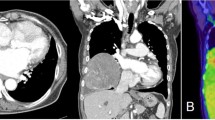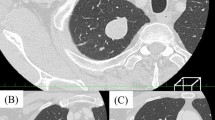Abstract
Purpose
We attempted to identify the exact point of tumor eruption of a solitary fibrous tumor of the pleura (SFTP).
Methods
We morphologically classified 36 SFTPs into 5 categories. Type A showed a connection that included a bloodstream with the pleura on both sides. Type B only showed a connection that included a bloodstream with the visceral pleura, and had a non-bloodstream connection with the parietal pleura. Type C only showed a connection that included a bloodstream with the visceral pleura, and had no connection with the parietal pleura. Type D showed a non-bloodstream connection with the visceral pleura, and only showed a connection that included a bloodstream with the parietal pleura. Finally, type E had no connection with the visceral pleura, and only showed a connection that included a bloodstream with the parietal pleura. The clinicopathological profiles of the tumors were investigated according to their type.
Results
The distribution of the 36 SFTPs was as follows: A (19 %), B (6 %), C (67 %), D (0 %) and E (8 %). The tumors categorized as type A tended to be large in size.
Conclusions
SFTPs commonly arise from the visceral pleura and in accordance with tumor progression they will form a non-bloodstream connection with the parietal pleura. Finally, a vascular pedicle will arise with the parietal pleura.

Similar content being viewed by others
References
Klemperer P, Rabin LB. Primary neoplasms of the pleura. A report of five cases. Arch Pathol. 1931;11:385–412.
El-Naggar AK, Ro JY, Ayala AG, Ward R, Ordonez NG. Localized fibrous tumor of the serosal cavities. Immunohistochemical, electron-microscopic, and flow-cytometric DNA study. Am J Clin Pathol. 1989;92:561–5.
Flint A, Weiss SW. Cd-34 and keratin expression distinguishes solitary fibrous tumor (fibrous mesothelioma) of pleura from desmoplastic mesothelioma. Hum Pathol. 1995;26:428–31.
Al-Izzi M, Thurlow NP, Corrin B. Pleural mesothelioma of connective tissue type, localized fibrous tumour of the pleura, and reactive submesothelial hyperplasia. An immunohistochemical comparison. J Pathol. 1989;158:41–4.
Cardillo G, Facciolo F, Cavazzana AO, Capece G, Gasparri R, Martelli M. Localized (solitary) fibrous tumors of the pleura: an analysis of 55 patients. Ann Thorac Surg. 2000;70:1808–12.
England DM, Hochholzer L, McCarthy MJ. Localized benign and malignant fibrous tumors of the pleura. A clinicopathologic review of 223 cases. Am J Surg Pathol. 1989;13:640–58.
Aydemir B, Celik S, Okay T, Dogusoy I. Intrathoracic giant solitary fibrous tumor. Am J Case Rep. 2013;14:91–3.
Miyoshi K, Okumura N, Kokado Y, Matsuoka T, Kameyama K, Nakagawa T. Solitary fibrous tumor of the pleura with a minute malignant component and diaphragmatic vascular supply: report of a case. Surg Today. 2008;38:344–7.
Weiss B, Horton DA. Preoperative embolization of a massive solitary fibrous tumor of the pleura. Ann Thorac Surg. 2002;73:983–5.
Fletcher CDM, Bridge JA, Hogendoorn PCW. WHO classification of tumours of soft tissue and bone. Lyon: IARC Press; 2013.
Okike N, Bernatz PE, Woolner LB. Localized mesothelioma of the pleura: benign and malignant variants. J Thorac Cardiovasc Surg. 1978;75:363–72.
Sung SH, Chang JW, Kim J, Lee KS, Han J, Park SI. Solitary fibrous tumors of the pleura: surgical outcome and clinical course. Ann Thorac Surg. 2005;79:303–7.
Wu M, Chen RK, Gurung L. Giant solitary fibrous tumor of the pleura. Thorac Cardiovasc Surg. 2005;53:185–8.
van de Rijn M, Lombard CM, Rouse RV. Expression of cd34 by solitary fibrous tumors of the pleura, mediastinum, and lung. Am J Surg Pathol. 1994;18:814–20.
Koelsche C, Schweizer L, Renner M, Warth A, Jones DT, Sahm F, et al. Nuclear relocation of stat6 reliably predicts NAB2/STAT6 fusion for the diagnosis of solitary fibrous tumour. Histopathology. 2014;65:613–22.
Doyle LA, Vivero M, Fletcher CD, Mertens F, Hornick JL. Nuclear expression of STAT6 distinguishes solitary fibrous tumor from histologic mimics. Mod Pathol. 2014;27:390–5.
Yoshida A, Tsuta K, Ohno M, Yoshida M, Narita Y, Kawai A, et al. STAT6 immunohistochemistry is helpful in the diagnosis of solitary fibrous tumors. Am J Surg Pathol. 2014;38:552–9.
de Perrot M, Fischer S, Brundler MA, Sekine Y, Keshavjee S. Solitary fibrous tumors of the pleura. Ann Thorac Surg. 2002;74:285–93.
Masson EA, MacFarlane IA, Graham D, Foy P. Spontaneous hypoglycaemia due to a pleural fibroma: role of insulin-like growth factors. Thorax. 1991;46:930–1.
Zafar H, Takimoto CH, Weiss G. Doege-Potter syndrome: hypoglycemia associated with malignant solitary fibrous tumor. Med Oncol. 2003;20:403–8.
Filosso PL, Asioli S, Ruffini E, Rovea P, Macri L, Sapino A, et al. Radical resection of a giant, invasive and symptomatic malignant solitary fibrous tumour (SFT) of the pleura. Lung Cancer. 2009;64:117–20.
Watts DM, Jones GP, Bowman GA, Olsen JD. Giant benign mesothelioma. Ann Thorac Surg. 1989;48:590–1.
Lococo F, Cesario A, Cardillo G, Filosso P, Galetta D, Carbone L, et al. Malignant solitary fibrous tumors of the pleura: retrospective review of a multicenter series. J Thorac Oncol. 2012;7:1698–706.
de Perrot M, Kurt AM, Robert JH, Borisch B, Spiliopoulos A. Clinical behavior of solitary fibrous tumors of the pleura. Ann Thorac Surg. 1999;67:1456–9.
Magdeleinat P, Alifano M, Petino A, Le Rochais JP, Dulmet E, Galateau F, et al. Solitary fibrous tumors of the pleura: clinical characteristics, surgical treatment and outcome. Eur J Cardiothorac Surg. 2002;21:1087–93.
Acknowledgments
None.
Conflict of interest
The authors have no conflicts of interest to declare.
Author information
Authors and Affiliations
Corresponding author
Rights and permissions
About this article
Cite this article
Kamata, T., Sakurai, H., Nakagawa, K. et al. Solitary fibrous tumor of the pleura: morphogenesis and progression. A report of 36 cases. Surg Today 46, 335–340 (2016). https://doi.org/10.1007/s00595-015-1176-5
Received:
Accepted:
Published:
Issue Date:
DOI: https://doi.org/10.1007/s00595-015-1176-5




